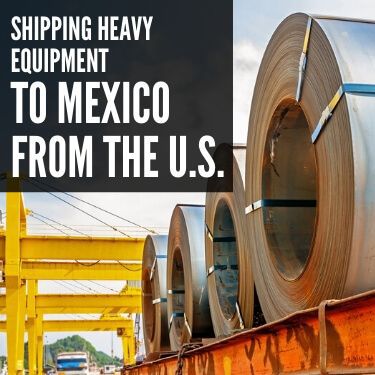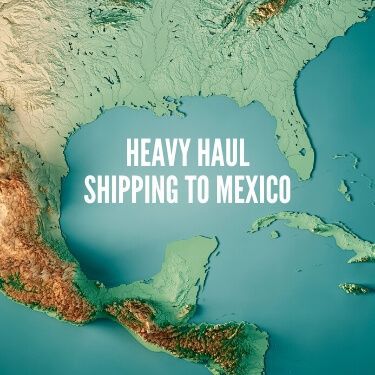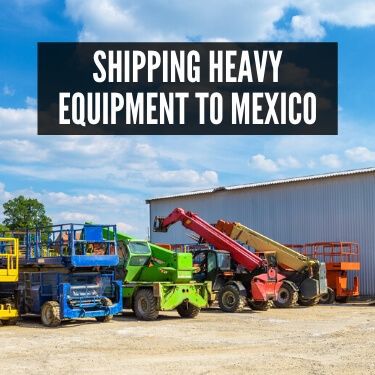
Por
 Copiar URL al Portapapeles
Copiar URL al Portapapeles
Heavy equipment isn’t a pleasure to move across town, let alone over a border. So now your company is shipping heavy equipment to Mexico from the U.S. and it immediately seems like a daunting task.
The process of shipping heavy equipment to Mexico can be more bearable by knowing what you’ll need to do from a documentation standpoint, and also the specific requirements. Also difficulties can arise and having an idea on how to deal with those will make everything easier.
Table of Contents

No matter where in the United States your shipment originates from, it is going to end up crossing the border while exporting to Mexico at points in either California, Arizona, New Mexico or Texas via a transportation company.
So it’s important to know what channels you can ship your heavy haul equipment through. Many of the major North America gateways to cross the border into Mexico that can accommodate the shipping of heavy equipment are located in the following cities, listed with the corresponding Mexican cities:
Texas
New Mexico
Arizona
California
Once you’ve figured out what point of entry makes the most sense for your Mexican imports, it’s time to look at what you’ll have to have in place before shipping. Each state has its own rules for bigger than normal shipments. But the general rule of thumb is oversized cargo exceeds:
According to U.S. federal law, there are also restrictions for weight on a per-axle basis. It may necessitate more axles to better distribute the load if the weight exceeds the law.
The amount of items you could possibly transport are numerous. Some of the equipment you might be looking to move includes:
Due to America’s agreement with Mexico under the North American Free Trade Agreement (NAFTA), heavy machinery or equipment made in the U.S. is not subject to any tariffs. If the equipment or machinery was manufactured somewhere other than the United States or Canada, tariffs would be assessed.
For this reason, it might save you money overall to buy American- or Canadian-made equipment and export it to Mexico than buying potentially cheaper equipment from a non-NAFTA country and then paying high duties to get it into Mexico.

The responsibility of filing the correct paperwork and making sure your equipment is ready to be imported is just as important as figuring out how to get it into Mexico.
Customs clearance is one of the biggest hurdles a company will encounter. As with any other items one would ship to Mexico, basic import and export documents are required:
You will need a Mexican customs broker to facilitate the importation and a Mexican business as a registered buyer to prove your intent.
Next, a U.S. transporter will be required to get the shipment to the border. Once there, the freight will be handed off to a Mexican shipper because only a very small amount of U.S. companies are allowed to transport within Mexico. Also note it’s worth allocating some time for the equipment to clear Mexican customs.
The Pedimento de Importacion is Mexico’s basic import document. The country needs import and export documentation for all commercial crossings, including a completed pedimento.
This document can only be completed by a Mexican customs broker at the behest of the importer — which is probably a good thing, partially because the document must be prepared in Spanish. Pedimentos are notoriously complex and specific codes must be used to correctly fill it out.
The pedimento also stands as proof that you legally imported your goods into Mexico. It’s a good idea to ask for a copy and keep it for your records. If the Mexican government did an audit and you couldn’t produce proof, they could seize the goods.
Heavy haul equipment being shipped could be any variety of items. Construction vehicles, generators, turbines, farming equipment, beams to help build bridges and industrial machinery are just some of the items imported through heavy haul shipping.
Transporting huge, cumbersome pieces of equipment requires certain types of vehicles to move them to their final destination. The most common vehicle used to bear the load is a flatbed truck. There are many advantages to using this mode of transportation:
Vehicles shipping oversized items are mandated by federal law to have special signage or markings. Other things that could be required include pilot cars or escort vehicles, safety flags, banners designating an oversized load and rotating yellow lights.
Once you’ve decided to ship your heavy equipment to Mexico, let R+L Global Logistics handle all your transportation needs. R+L Global Logistics is a third-party logistics company linking businesses with transportation for over 30 years.
R+L Global Logistics customers will enjoy a 99.5% on-time rate and real-time tracking of your freight. We offer a variety of services to support the supply chain of our customers, all backed by great customer service to give you confidence during the import process.
Contact us for a Mexico cross border freight quote today and see how R+L Global Logistics can fully support your business’ success.
 Copiar URL en el Portapapeles
Copiar URL en el Portapapeles

This article gives detail about shipping heavy equipment to Mexico from the us. This article gives suggestions on heavy equipment. I enjoyed reading while going through this article and this is the best link for gaining all the information about it.Great to find Earthmovingandcivil.co.nz which has same kind of wonderful tips, if possible then visit.
This blog happens to be one of the best blog on the shipping heavy equipment to mexico from us. It is just a proper critique blog, would suggest others it as well. Keep sharing such informative articles in future, will be appreciated.They offer same information here Bvtengineering.com one must check them also.
This is really appreciated that you have presented this data over here. It will be very helpful to understand about shipping heavy equipment to Mexico from the us. Great post to share, thanks for publishing this here!!
I loved your blog and thanks for publishing this about shipping heavy equipment to Mexico from the us!! I am really happy to come across this exceptionally well written content. Thanks for sharing and look for more in future!!I have seen similar information at one place, you can also see on Smcnz.nz